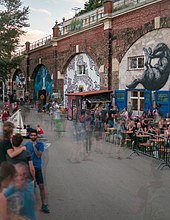Ghosting
As a ghost (often English ghosting called) is called a weakly visible, usually less luminous copy of an image that is offset from the main image.
Television reception
Ghost images occur almost exclusively with analog , terrestrial or wired transmission of television programs - the ghost image is usually shifted a few centimeters to the right. With modern digital transmission methods such as DVB-T or DVB-C , they do not occur in principle.
Signal reflections
The cause of the ghost image is multipath reception of the transmitted high-frequency signal due to reflection on objects such as house walls. The signal reaches the receiving antenna in two different ways, the transit times of which differ from the transmitting antenna by a few microseconds. As a rule, the stronger signal is received on the shorter, more direct route. This synchronizes the line start on the left edge of the screen with the sync pulse.
If the second signal has now traveled a detour of 3000 m because of the detour via the reflecting surface, it arrives 10 µs later, the corresponding pixels appear 10/64 of the image width further to the right than expected. This unwanted additional signal is shown in the adjacent picture with 35% amplitude offset to the right. Both signals add up in the receiver, and the sum affects the brightness of the pixels. Overall, you can see the superimposition of two images. If both signals are equally strong, reception is severely disturbed because of the duplicate sync pulses.
The reception via the unwanted signal path can be weakened in terrestrial transmission by directional antennas such as Yagi antennas .
Signal crosstalk
Ghost images can also result from crosstalk from neighboring analog transmission channels if the signal level in the TV cable network is too high or the antenna amplifier does not separate the channels precisely enough (e.g. due to a malfunction ). Then the same television program cannot be seen as a ghost image , but the corresponding neighboring station.
Scanning tunneling microscopy
When scanning tunneling microscopy ghosting can be caused by multiple scanning tips because the grids structures scan multiple different tips at the same location.
3D screens
In the case of 3D monitors and television sets, ghost images are a faulty stereoscopic display in which the image is temporarily visible to the right and left eye in high-contrast areas of the image. LCDs in connection with 120 Hz 3D shutter glasses are particularly prone to ghosting, while DLP 3D projectors with well-adapted 3D shutter glasses do not show ghosting.
Electronic paper
With electronic paper , the effect can occur that after a screen update, remnants of the previous image remain. This is mostly due to the energy-saving mechanisms of the e-book readers ; when the energy-saving functions are deactivated or after a few refresh cycles, the ghost images usually disappear again.
Panorama software
When composing panoramas from individual images (using special software), moving objects can appear in different positions on several individual images. If the program does not offer a corresponding correction process ("de-ghosting"), these objects (e.g. people) can then be seen as "ghosts" after they have been combined, ie several times, in sections or semi-transparent in the finished panorama.
The same effect can also arise when creating HDR photos from multiple source images.
supporting documents
- ↑ Rita Deutschbein: 4th Kindle in the test: Amazon's new e-book reader knows German. Test at teltarif.de from November 15, 2011.




